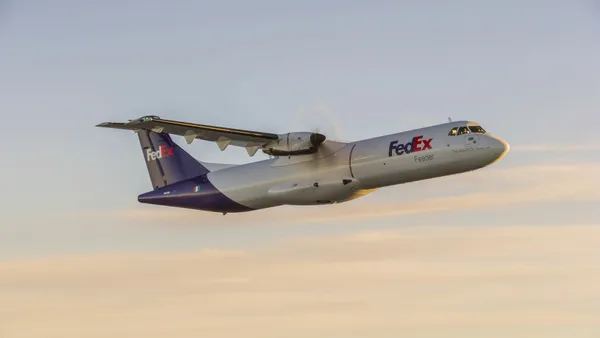Dive Brief:
- Levi Strauss is now shipping most of its product through the U.S. East Coast amid a continued "challenge in Long Beach," CEO Chip Bergh said in an earnings call last week.
- Delays have been built into lead times for the 20% of products the brand still ships through the West Coast, Bergh said, who is also the company's president and director. Levi's declined to comment on this story.
- Supply chain issues cost Levi's "half a point of growth" or "in the range of $7 million to $8 million in the quarter," according to Bergh. "Our expectation for the second half is there will continue to be challenges, but we're going to be airfreighting more."
Dive Insight:
It is not the first time Levi's has talked about shifting cargo volumes due to supply chain disruptions. The brand reduced its manufacturing operations in China from 16% in 2017 to less than 2% in 2019 in an attempt to shield its supply chain from trade wars.
A few months ago Levi's faced a different problem: inventory shortages were leading to lost sales.
A surge in demand was the leading cause of these shortages, but supply chain issues did not help. A global container shortage was already challenging the movement of goods in the first half of 2021, when an import boom caused congestion in the ports of Los Angeles and Long Beach. At the same time, spikes in cases of COVID-19 disrupted both production and distribution worldwide, leading, for example, to congestion in Yantian, China.
Faced with these challenges, various brands chose to absorb the higher one-time costs of airfreight than lose revenues from out-of-stocks.
During last quarter's earnings call, Executive Vice President and CFO Harmit Singh said the company resorted to airfreighting more products to help keep goods in stock.
But as supply chain disruptions have continued for months, companies are adjusting their long-term plans.
"Chip referred to us airfreighting product in the second half and we've built in that into our gross margin guidance," Singh said during the Q2 earnings call. "Our assumption is longer term we will revert back to the old norm of shipping the products so we may not need to airfreight as much."
The decision to divert freight was one of many actions Levi's supply chain team took to mitigate disruptions and plan for the future.
"A lot of people are talking about not being able to get containers, not being able to get onto a ship," said Bergh. "The team has done an extraordinary job on getting us guaranteed space, guaranteed pricing as well, which is helping us to control our costs."
Looking ahead, Levi's also negotiated limits to cost increases through mid-2022, opened a new owned-and-operated distribution center in Nevada and tested AI-driven forecasting, according to executives.
But the improvements to forecasting, in particular, are key to the company's long-term supply chain strategy.
"Results from our first wave test showed that AI-driven demand forecasting improved accuracy," Bergh said. "So, scaling it should enable more precise inventory investment, lead to less markdowns and clearance, prevent waste, and enhance sustainability, all of which will improve our margins."














